#one of them is on the cross (<- self crucified) and the other has propped up a ladder and climbed up it and theyre kissing
Explore tagged Tumblr posts
Text
they are so yuckydisgusting creepy in love with each other and that is at the end of the day so Cringe to me. like just calm down. girls please
#like literally okay. wots aul this then.#one of them is on the cross (<- self crucified) and the other has propped up a ladder and climbed up it and theyre kissing#each other so sloppily and with so much tongue and so noisily too.... and well i just think there was no need. for that little performance#if they just had some couth....then i could have some couth and i wouldnt be blogging about them in twenty twenty three. grow up#r/s
24 notes
·
View notes
Text
The Pilgrimage of Eden’s Gate
After I liberated the Henbane River, I decided to find Faith’s Pilgrimage and “walk the path” for myself. It’s quite a bit longer than I thought, and it crosses almost the entire region. It is a narrow path, distinguished from other game trails and hiking paths by the white petals on the ground, and you’ll find blood and bodies along its length. It takes nearly a day and a half in-game to follow the entire thing on foot while sprinting, but I took the extra time and walked it without followers to let the scenery sink in and give me time to reflect. If you follow it, don’t forget to look up from time to time. It has some of the best views in the region.
Some meta (with pictures!) is below the cut for anyone who hasn’t yet walked the path.
The Pilgrimage begins here, at a small campsite presumably made by Eden’s Gate.

It’s just below Joseph’s Word, the statue on the mountain called Angel’s Peak. From the fast-travel arrival point of Joseph’s Word, turn around and almost a short distance behind you, you should see a tall crucifix. A footpath runs underneath it, and following that will lead you to the pair of cabins that makes up the camp. One of the cabins is pristine and well cared-for, with garlands and bouquets of Bliss flowers, clean mattresses, sturdy furniture, and some crisp Books of Joseph lying around for perusal. The other cabin, however, is a pigsty. Garbage is lying around, blood splatters line the walls, instead of beds you have sleeping bags and blankets strewn on the floor and on the bed frames, and a couple bedpans are scattered around.
I assume the clean cabin is for people who choose to undertake the Pilgrimage, and the other is for those who go unwillingly. Or, the messy one could be for all pilgrims while the other is for those who guide them along the path. Another possibility is that the messy one is for Angels and the other is for people who still retain their minds. But what complicates these assumptions is the letter found in the messy cabin.

This certainly seems to be addressed to a woman who willingly traveled the Pilgrimage. I know Joseph’s words here would make me want to walk it for myself, provided I had my good sneakers with me.
The stones laid upon the path Joseph mentions are at checkpoints along the Pilgrimage, thirteen in all, like this one.
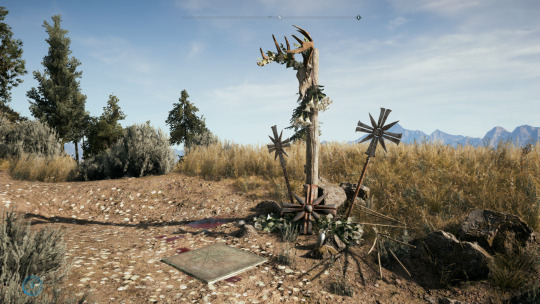
Each one has a stone laid in the ground engraved with the emblem of the Project at Eden’s Gate and a short description of a significant event in the Project’s lifespan. It begins right outside the cabins with this message.

To start the Pilgrimage, go downhill from this first marker. Once you recognize the path with the white petals, it’ll be easily identifiable for the rest of your journey. Just bring a lot of ammo, as you’ll be ambushed rather often by the local wildlife (I encountered mostly cougars and bison with the occasional turkey) and for the love of all that’s holy, don’t bring Sharky Boshaw. I love him, but I died in too many wildfires while initially trying to follow this path. I didn’t even make it to the fifth checkpoint before I sent him home.
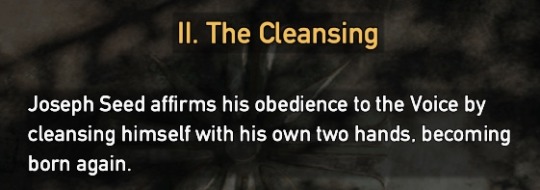
The second checkpoint’s message about Joseph “cleansing” himself could either refer to self-flagellation (which would certainly explain at least some of the scars on his torso, some of which look fairly recent, others look very deep and painful), the tattooing/scarification of at least one of the seven deadly sins on those who join the Project, or a much tamer self-baptism. It’s uncertain, but I’d guess it’s the first one.
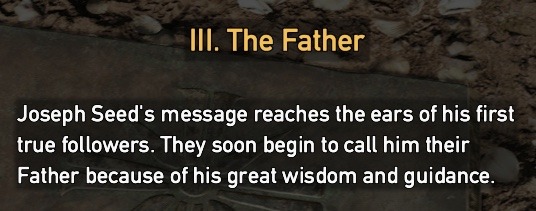
As you follow the Pilgrimage, you’ll find that nearly every checkpoint is at or near a fork in the path, where one fork has the white petals and the other does not. More often than not, the plain fork leads to one of the sixteen Shrines dotted across the Henbane River region, but at the third intersection, found next to a Bliss field in an open plain, taking the plain path to the right of the stone marker will lead you to an abandoned chapel. In this chapel, you’ll see a statue of a crucified Christ propped up in a shadowy corner in the back with a cardboard box over its head. Under the box is a key to a safe nearby, but it isn’t the key that interests me. The position of the box AND the statue itself seems to suggest that someone felt like they didn’t want Him watching them, whether that’s because they were doing something they didn’t want seen or they just felt ashamed. Because of the note I found in the room with the safe, I strongly believe it’s the latter.
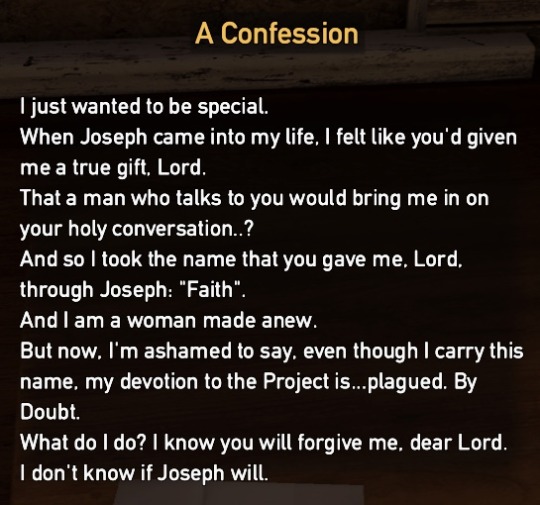
Whether this Faith is the current one - Rachel Jessop - or one of her predecessors, I can’t say, but based on how the current Faith reacts to the burning of her personal Book of Joseph (”You have no idea what he’ll do to me!”) and what she desperately cries in the final stage of her boss fight (”You will never know what I know!” and “It wasn’t my fault! None of this was my fault!”) this note wouldn’t be out of character for her.
Once you return to the path, you’ll encounter another checkpoint with another marker before you continue on.
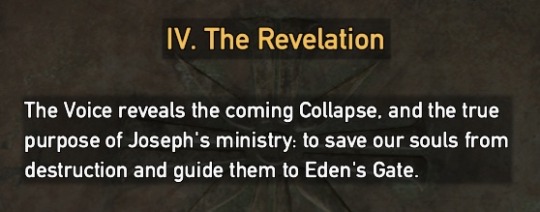
The one after this is the one that really interests me, firstly because it officially lists Faith as Joseph’s blood family along with Jacob and John, which implies that she or he (whoever oversaw the creation of the Pilgrimage) or both of them consider Faith a blood relative.

This stone also marks a fork in the path, and stepping away from the Pilgrimage leads to another Shrine - but this one is located in the center of an amphitheater with a well-tended garden of Bliss flowers around it.
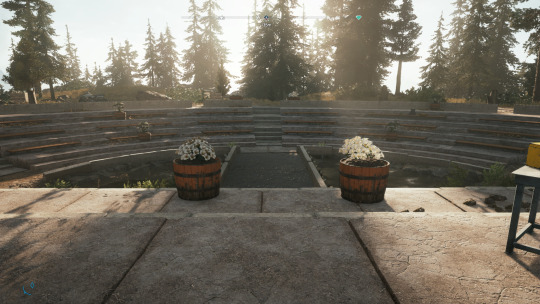
It looks far more ceremonial than any of the other Shrines, and this leads me to believe that perhaps Faith and/or Joseph hold sermons for the faithful there. The fact that this is at the location of the family stone doesn’t seem like a coincidence. Because pilgrims are meant to reflect on each checkpoint, it seems fitting for Joseph, Faith, or one of her Priestesses to officially welcome pilgrims into the Eden’s Gate family here with a ceremony or sermon in this amphitheater.
Some time after passing this checkpoint, you’ll cross one of the many bridges you find on this trail, but this one has a small surprise at the end. On top of a Bliss crate, you find a med kit, a stick (for hitting people with) and a letter from the Resistance.

If the amphitheater from the fifth marker is really a place to welcome newcomers into the family, this note could be considered either too little, too late, OR placed in just the right spot to plant doubt in the heart of the pilgrim who reads it.
Now, the next few stones continue with the history of the Project. The sixth marker interests me because of how it describes why Joseph uprooted the Project from its original home in Georgia (so implied in the Book of Joseph). This suggests that someone inside the cult was either a plant by law enforcement or they found a conscience and reported the things they’d seen.

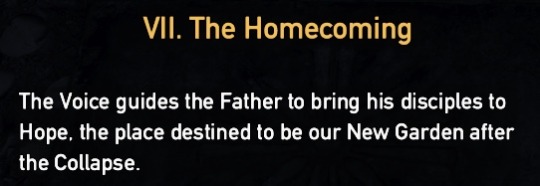

The seventh and eighth stones refer to Hope County as simply “Hope,” which, like “Faith,” likely stands more as a symbol than a place or person. Faith is not only a woman, she’s an icon for the cult. In the same vein, “Hope” is the the New Garden - not just a place to grow their Bliss, their family, and their religion, but also the new Garden of Eden.
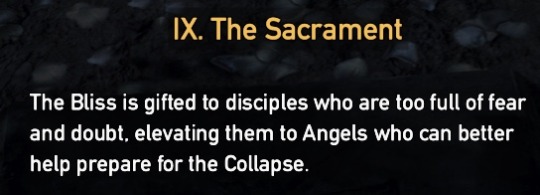
The ninth stone also piques my interest because of how it mentions “disciples.” These could be some of (or all of) the cult VIPs we see and kill. They all have the same Bliss haze around their heads as Angels do, and all the ones I’ve seen have the same white eyes. This could be why killing them grants Resistance Points - they were some of Joseph’s first followers, the first and most effective Angels, and their loss hurts the cult more than just an average Peggie. Additionally, the Bliss was said to be “offered” to them. While this very well could be a nice way of saying “we forced it down their throats,” it could also have been taken willingly as a sacrament, as the title implies.
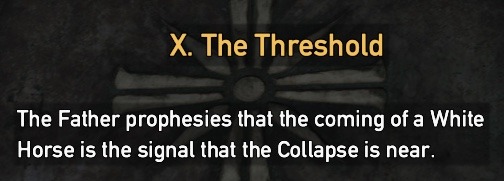
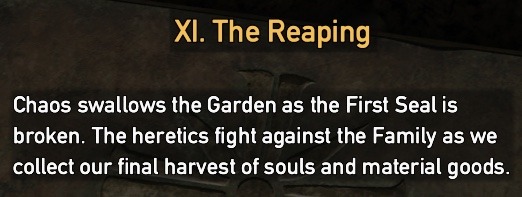
We all know what the tenth and eleventh stones are referring to.

The twelfth stone is very specific in saying that fire will cleanse the earth. In the Bliss vision where Joseph speaks to you personally, you see fire and a nuclear mushroom cloud, implying he feels certain that atomic bombs will be the end of the world.
And finally, the thirteenth stone. The “Gates” mentioned are the Herald’s bunkers.

The end of the Pilgrimage is nearby, and you’ll find yourself back at Joseph’s Word. Staying to the right as you climb the steps seems to be the intended path for pilgrims, and I assume cultists are typically nearby to lead pilgrims up into the statue and out onto the book. And just like the deputy did in their first Bliss vision, it looks like some pilgrims are expected to take a leap of faith.
This is what they’re faced with when they look down.
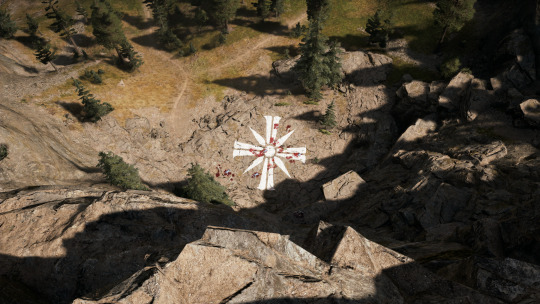
It’s far less pretty from the ground.
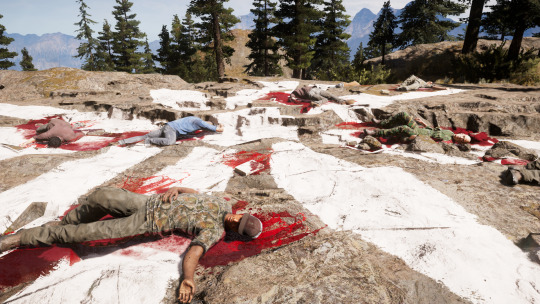
#far cry 5#meta#faith seed#joseph seed#the project at eden's gate#the pilgrimage of eden's gate#gracelogs#tw: blood
185 notes
·
View notes
Text
Met. Tikhon’s Sanctity of Life Message
Archpastoral Message of His Beatitude, Metropolitan Tikhon Sanctity of Life Sunday January 21, 2018
To the honorable Clergy, venerable Monastics, and pious Faithful of the Orthodox Church in America,
My beloved brothers and sisters in Christ:
From the moment they were born, both Moses and our Lord Jesus Christ faced great danger: as infants someone wanted each of them dead. Moses’s life was saved because the Hebrew midwives feared God more than Pharaoh, so they refused to follow the order to kill the newborn males (Ex. 1:17). And our Savior’s life was spared because of angelic intervention (Mt. 2:13).
But the Holy Innocents were not spared. Herod’s lust for power, or rather his deep-seated insecurity, led to the massacre of a multitude of small children, and the bitter weeping of their inconsolable mothers. We sing of this at the Ninth Royal Hour on Christmas Eve: “Mothers were bereft of their infants, and by an untimely death their babes were bitterly harvested. Breasts grew dry and sources of milk were stopped. Great was this calamity!”
The root of sin and specifically of violence toward our fellow human being has not changed since those times. It has always been our passions: anger, fear, judgment, despair, jealousy, pride, vanity, to name only a few. Moreover, the Fathers of our Church have always taught that the nature of all passions is one and the same: love of the self. This is, in the words of our Lord, “not to think the things of God, but those of man” (Mt. 16:23), or in other words not to think as God does, but as people do. We learn from the Apostle Paul how God thinks. He does not think of His divinity as a thing to hold onto, but empties Himself taking the form of a servant (Phil. 2:6-7). The mind of God is not only not to kill, but to give life to the world through His death (John 6:33, 51).
Locking ourselves within our own minds and setting ourselves as the standard of life, not only do we not see God for what He is, but we don’t see our fellow human beings for what they are. They become objects of our ideas and plans, props in our own life narratives, subjects of our own desires. We hurt others in so many ways just to make them fit us better. The calamities we inflict on each other are not different in nature since the beginning of time, they are only greater. Today we have means to injure others on extraordinarily larger scales. We have the means to hurt others all the way on the other side of the planet with the typing of 280 characters. We have means to execute the condemned by the thousands. We have means to destroy the enemy by the hundreds of thousands. Finally, we have means to kill the unborn by the millions and billions. The only difference between us and the sinners of ancient times is that we have greater means for putting ourselves first and imposing ourselves on others.
Yet, the scariest of all things is not even the scale of our means of violence. Rather it is the fact that our human mind has devolved in its own universe to the point of finding justification for all these terrible violences. At times it even seems that we are drawing near to justifying anything. Human law, established firmly in “the things of men” and not in those of God, follows suit. So many wars have been legal. So many executions have been legal. So many genocides—legal. Christ’s own crucifixion—legal. So much violence has been done in the name of the law and of the good of the human being.
In front of this terrible reality some of us will be drawn to prayer. Others will be drawn to helping all the victims of this terrible violence. Others will be drawn to changing the law. But in front of all of us, regardless of our inclinations, is put forth the only Way and the only conquering of death and victory of life—Christ, the one who “died for the life of the world” (John 6:51). There is a great mystery hidden in this truth, because Christ died for the life of the world at the hands of the world. This is how St. John Chrysostom puts it:
Tell me, what is the goal of the Gospel of grace? Why the revelation of the Son of God in the flesh? So that we bite and devour each other?
...Christ didn’t die only for friends or for His own, but also for His enemies, for tyrants, for impostors, for those who hated and crucified Him…
Throw the net of love, not so that the lame will fall, but rather that he be healed… and thus having searched the hidden depths, pull out from the chasm of perdition the one drowned by his thoughts…
Do not hate! Do not turn away! Do not persecute! Rather, show him pure and true love.
And how Christ died “for the life of the world” at the hands of the world clarifies for us the most crucial thing, namely that life has only one source and only one victory: selfless or self-sacrificial love. Let us be selfless love for all and we—in the one who is Love and Life itself—will conquer death:
Be persecuted, but persecute not. Be crucified, but crucify not. Be wronged, but wrong not. Be slandered, but slander not. Have clemency, not zeal, with respect to evil. Lay hold of goodness, not justice. Justice does not belong to the Christian way of life, and there is no mention of it in Christ’s teaching. Rejoice with them that rejoice, and weep with them that weep: for this is the sign of limpid purity. Suffer with the sick, and mourn with sinners; with those who repent, rejoice… Be a partaker in the sufferings of all men, but keep your body distant from all. Rebuke no man, revile no man, not even those who live very wickedly. Spread your cloak over the man who is falling and cover him. (St. Isaac of Syria)
May the world see our love, receive it from our own cross, and fill itself with life in it!
With love in Christ,
+ Tikhon Archbishop of Washington Metropolitan of All America and Canada
1 note
·
View note